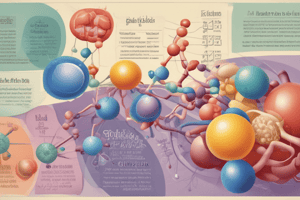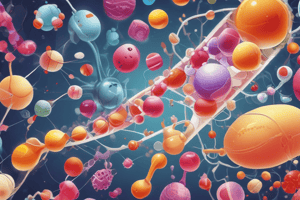Podcast
Questions and Answers
What effect does high acidity have on calcium levels in food during processing?
What effect does high acidity have on calcium levels in food during processing?
- It has no effect on calcium levels.
- It changes calcium to a more absorbable form.
- It promotes calcium loss. (correct)
- It enhances calcium retention.
Which method is not typically associated with calcium fortification?
Which method is not typically associated with calcium fortification?
- Adding calcium to water. (correct)
- Adding calcium to bread.
- Adding calcium to cereals.
- Replacing calcium lost in fruit juice processing.
How can the retention of calcium be optimized during food processing?
How can the retention of calcium be optimized during food processing?
- By increasing the temperature to enhance cooking speed.
- By boiling food for an extended period.
- By maintaining an alkaline pH.
- By reducing exposure to water through gentle processing methods. (correct)
Which of the following foods contains the highest amount of calcium?
Which of the following foods contains the highest amount of calcium?
What role does potassium play in food texture?
What role does potassium play in food texture?
What impact does prolonged storage at high temperatures have on calcium?
What impact does prolonged storage at high temperatures have on calcium?
During which cooking process is potassium most likely to be lost?
During which cooking process is potassium most likely to be lost?
Which additive can enhance calcium retention in food?
Which additive can enhance calcium retention in food?
Which form of vitamin C is considered hydrophilic?
Which form of vitamin C is considered hydrophilic?
What pH level has been shown to make vitamin C less stable?
What pH level has been shown to make vitamin C less stable?
Which process involves adding micronutrients back to food lost during processing?
Which process involves adding micronutrients back to food lost during processing?
Which of the following is a water-soluble vitamin that is prone to degradation when exposed to light?
Which of the following is a water-soluble vitamin that is prone to degradation when exposed to light?
What is the result of ascorbic acid oxidation?
What is the result of ascorbic acid oxidation?
What effect do fructose and glucose have on vitamin C stability?
What effect do fructose and glucose have on vitamin C stability?
Which B vitamin is known as cobalamin?
Which B vitamin is known as cobalamin?
Which of the following is NOT a factor affecting the stability of B vitamins during storage?
Which of the following is NOT a factor affecting the stability of B vitamins during storage?
What is the primary method through which sodium loss occurs during heat treatment of food?
What is the primary method through which sodium loss occurs during heat treatment of food?
Which food item has the highest sodium content?
Which food item has the highest sodium content?
What type of iron is found in plant-based foods?
What type of iron is found in plant-based foods?
What impact can pH adjustment have on sodium content in food?
What impact can pH adjustment have on sodium content in food?
Which of the following is a characteristic of heme iron?
Which of the following is a characteristic of heme iron?
Which processing method can reduce iron bioavailability in food?
Which processing method can reduce iron bioavailability in food?
Which flavor-enhancing property is contributed by iron in fermented foods?
Which flavor-enhancing property is contributed by iron in fermented foods?
What can impact the restoration of sodium in processed foods?
What can impact the restoration of sodium in processed foods?
What is the primary function of sodium in food?
What is the primary function of sodium in food?
Which of the following methods can increase zinc absorption in foods?
Which of the following methods can increase zinc absorption in foods?
What happens to potassium compounds during heat processing?
What happens to potassium compounds during heat processing?
Which food contains the highest amount of potassium per 100g?
Which food contains the highest amount of potassium per 100g?
How does sodium function in relation to pH control in foods?
How does sodium function in relation to pH control in foods?
What is the method of direct intervention used to address zinc deficiency?
What is the method of direct intervention used to address zinc deficiency?
Sodium can increase in foods during processing through which process?
Sodium can increase in foods during processing through which process?
Which type of breeding approach is associated with biofortification for increasing zinc content?
Which type of breeding approach is associated with biofortification for increasing zinc content?
What is the primary difference between fortification and enrichment of food products?
What is the primary difference between fortification and enrichment of food products?
Which food product contains the highest amount of iron?
Which food product contains the highest amount of iron?
What role does zinc play in the body?
What role does zinc play in the body?
How does milling affect zinc content in grains?
How does milling affect zinc content in grains?
Which process can enhance the bioavailability of zinc in food products?
Which process can enhance the bioavailability of zinc in food products?
What type of zinc is typically added during the fortification of processed foods?
What type of zinc is typically added during the fortification of processed foods?
What effect does heat treatment, such as roasting, have on zinc content in food?
What effect does heat treatment, such as roasting, have on zinc content in food?
What is the purpose of restoration in food processing?
What is the purpose of restoration in food processing?
What is the primary purpose of iodized salt in public health?
What is the primary purpose of iodized salt in public health?
Which food processing method is likely to lead to a reduction in iodine content due to high temperatures?
Which food processing method is likely to lead to a reduction in iodine content due to high temperatures?
What is the range of iodine content found in seaweed?
What is the range of iodine content found in seaweed?
What is a consequence of long-term storage for iodine in foods?
What is a consequence of long-term storage for iodine in foods?
What is the purpose of food additives?
What is the purpose of food additives?
What is an E-number?
What is an E-number?
Which gas is commonly used in modified atmosphere packaging for potato chips?
Which gas is commonly used in modified atmosphere packaging for potato chips?
What is the role of the Joint FAO/WHO Expert Committee on Food Additives (JECFA)?
What is the role of the Joint FAO/WHO Expert Committee on Food Additives (JECFA)?
Flashcards
Ascorbic Acid Degradation
Ascorbic Acid Degradation
Ascorbic acid, or vitamin C, breaks down when exposed to factors like temperature, pH, and light.
Vitamin C Stability
Vitamin C Stability
Vitamin C is more stable at lower pH levels (acidic) and susceptible to degradation at higher pH (alkaline).
B Vitamin Degradation
B Vitamin Degradation
B vitamins, water-soluble, are unstable to light, heat, moisture, and chemical changes during food processing and storage.
Fortification
Fortification
Signup and view all the flashcards
Enrichment
Enrichment
Signup and view all the flashcards
Active Form of Thiamine
Active Form of Thiamine
Signup and view all the flashcards
Active Form of Riboflavin
Active Form of Riboflavin
Signup and view all the flashcards
Food Processing Impact
Food Processing Impact
Signup and view all the flashcards
Calcium's Role in Food
Calcium's Role in Food
Signup and view all the flashcards
Calcium Loss During Processing
Calcium Loss During Processing
Signup and view all the flashcards
Calcium Fortification
Calcium Fortification
Signup and view all the flashcards
Calcium Enrichment
Calcium Enrichment
Signup and view all the flashcards
Calcium Restoration
Calcium Restoration
Signup and view all the flashcards
Potassium's Function in Food
Potassium's Function in Food
Signup and view all the flashcards
Potassium: A Texture Modifier
Potassium: A Texture Modifier
Signup and view all the flashcards
Potassium's Flavor Impact
Potassium's Flavor Impact
Signup and view all the flashcards
Iron Fortification
Iron Fortification
Signup and view all the flashcards
Iron Enrichment
Iron Enrichment
Signup and view all the flashcards
Iron Restoration
Iron Restoration
Signup and view all the flashcards
Zinc's Role in Food
Zinc's Role in Food
Signup and view all the flashcards
Zinc's Antioxidant Activity
Zinc's Antioxidant Activity
Signup and view all the flashcards
Zinc's Microbial Control
Zinc's Microbial Control
Signup and view all the flashcards
Zinc Fortification
Zinc Fortification
Signup and view all the flashcards
Zinc Enrichment
Zinc Enrichment
Signup and view all the flashcards
Potassium Degradation
Potassium Degradation
Signup and view all the flashcards
Phytate's Impact on Zinc
Phytate's Impact on Zinc
Signup and view all the flashcards
Reducing Phytate
Reducing Phytate
Signup and view all the flashcards
Sodium's Function in Food
Sodium's Function in Food
Signup and view all the flashcards
Sodium's Role in Fluid Balance
Sodium's Role in Fluid Balance
Signup and view all the flashcards
Sodium Increase During Processing
Sodium Increase During Processing
Signup and view all the flashcards
Sodium Migration
Sodium Migration
Signup and view all the flashcards
Sodium Loss in Food
Sodium Loss in Food
Signup and view all the flashcards
Sodium Loss Impact
Sodium Loss Impact
Signup and view all the flashcards
Heat Treatment and Sodium
Heat Treatment and Sodium
Signup and view all the flashcards
pH and Sodium Content
pH and Sodium Content
Signup and view all the flashcards
Iron's Role in the Body
Iron's Role in the Body
Signup and view all the flashcards
Heme vs Non-heme Iron
Heme vs Non-heme Iron
Signup and view all the flashcards
Iron's Functional Properties
Iron's Functional Properties
Signup and view all the flashcards
Iron Loss During Processing
Iron Loss During Processing
Signup and view all the flashcards
Food Additives
Food Additives
Signup and view all the flashcards
E-numbers & INS numbers
E-numbers & INS numbers
Signup and view all the flashcards
Modified Atmosphere Packaging (MAP)
Modified Atmosphere Packaging (MAP)
Signup and view all the flashcards
Iodine Fortification
Iodine Fortification
Signup and view all the flashcards
Iodine Enrichment
Iodine Enrichment
Signup and view all the flashcards
Iodine Restoration
Iodine Restoration
Signup and view all the flashcards
Iodine Loss in Food Processing
Iodine Loss in Food Processing
Signup and view all the flashcards
Iodine in Food Products
Iodine in Food Products
Signup and view all the flashcards
Study Notes
Food Chemistry - Vitamins
- Vitamins are organic substances needed in trace amounts for health and bodily functions.
- They were originally called "vitamines" and later renamed "vitamins."
- Vitamins are organic compounds, meaning they contain carbon.
- Humans get vitamins from food.
- 13 essential vitamins exist: A, C, D, E, and K, and the B vitamins (B1, B2, B3, B5, B6, B7, B9, and B12).
- Vitamins are categorized as either fat-soluble (A, D, E, K) or water-soluble (C and the B vitamins).
- Fat-soluble vitamins (A, D, E, K): Dissolve in fats and oils and typically stored in the body, thus they are generally more stable to processing. Found mainly in animal fats, vegetable oils, oily fish, nuts, green leafy vegetables, whole grains, wheat germ, and dairy products.
- Water-soluble vitamins (C and the B vitamins): Dissolve in water and are not stored in large quantities; need to be replaced daily. Found in fruits, vegetables, whole grains, legumes, and dairy products. They are less stable during processing and cooking.
Fat-Soluble Vitamins
- Vitamin A:
- Found in two forms: retinoids (active form, found in animal products) and carotenoids (plant pigments, provitamins which the body converts to active vitamin).
- Stable in inert atmospheres but unstable when heated with oxygen.
- Easily broken down with cooking and storage.
- Vitamin D:
- Produced in skin when exposed to UV light.
- Two forms: Vitamin D2 (ergocalciferol, plant-based) and Vitamin D3 (cholecalciferol, animal-based).
- Sensitive to heat, light, acid, and alkali (both forms).
- Loss depends on the specific food and heating methods.
- Vitamin E:
- A group of tocopherols and tocotrienols (lipid-soluble compounds).
- Antioxidant properties that prevent oxidation.
- Stable at ambient temperatures but breaks down with heat and oxygen.
- Degradation increases with temperature.
- Vitamin K:
- Three forms: K1 (phylloquinone, green leafy vegetables), K2 (menaquinones, animal foods), and K3 (menadione, synthetic form).
- Stable at room temperature, not degraded by cooking.
- Sensitive to light.
Water-Soluble Vitamins
- Vitamin C (ascorbic acid):
- Water-soluble, carbohydrate-like.
- Susceptible to oxidation.
- Loss happens when exposed to environmental changes (pH, temperature, humidity, salt, and radiation).
- Oxidation converts it to dehydroascorbic acid which is less stable.
- Stable at lower temperatures (pH and 24-45 °C.) and less stable at higher temperatures (70-90°C).
- Vitamin B-Complex:
- Water-soluble vitamins needed daily.
- Exist in several different forms (e.g., thiamine pyrophosphate, flavin adenine dinucleotide)
- Abundant in animal proteins, dairy, leafy greens, and beans.
- Can be lost through cooking that utilizes water.
Changes During Processing and Storage
- Processing techniques and storage conditions significantly impact vitamin retention.
- Factors include type of food, cooking method, temperature, exposure to light and oxygen.
- Fat-soluble vitamins generally more stable during processing than water soluble vitamins.
Fortification, Enrichment, & Restoration
- Fortification: Adding specific micronutrients to enhance nutritional value (e.g., adding vitamin D and calcium to bread).
- Enrichment: Replacing lost nutrients during processing (e.g., enriching refined flour with B vitamins).
- Restoration: Replacing nutrients lost during processing to recreate the food's original state (e.g., restoring natural fiber content to juice).
Food Chemistry - Minerals
- Minerals are essential inorganic elements necessary for many bodily functions.
- Categorized as macrominerals (needed in larger quantities) and microminerals/trace minerals (needed in smaller amounts). Examples include: Calcium, Potassium, Sodium, Iron, Zinc, and Iodine.
- Exist in food in different forms and interact with other components affecting the food's texture, flavor, and quality.
Changes in Processing and Storage of Minerals
- Heating and high temperatures cause loss of certain minerals.
- Acidic environments promote mineral loss while alkaline environments enhance retention.
- Prolonged storage, especially at high temperatures, can contribute to mineral degradation.
Retention of Minerals in Food Processing
- Methods to retain minerals include controlling temperature (using gentler methods like steaming instead of boiling), maintaining neutral or alkaline pH, and avoiding prolonged cooking in large amounts of water.
- Using specific food additives can affect mineral retention positively or negatively.
Studying That Suits You
Use AI to generate personalized quizzes and flashcards to suit your learning preferences.




